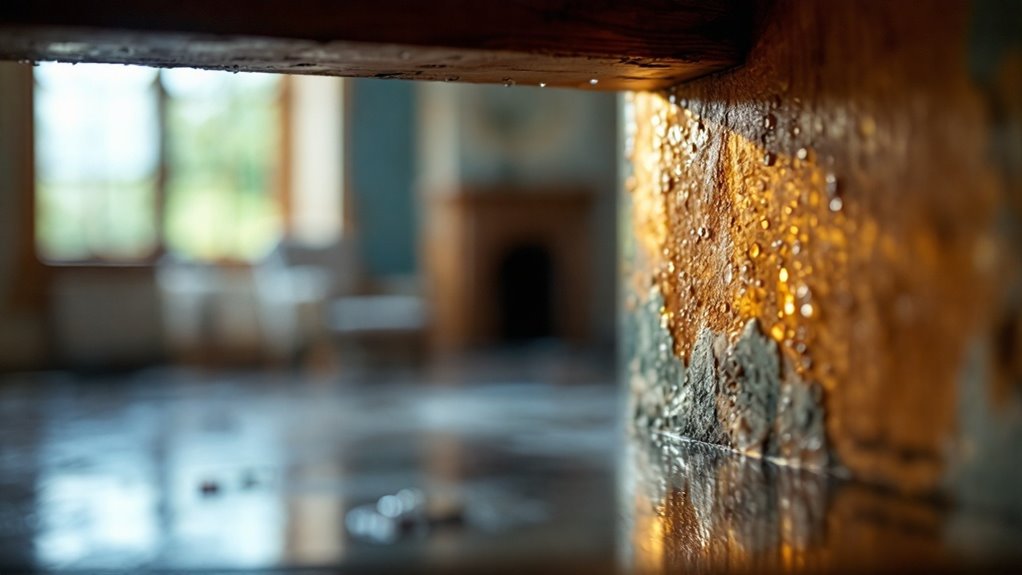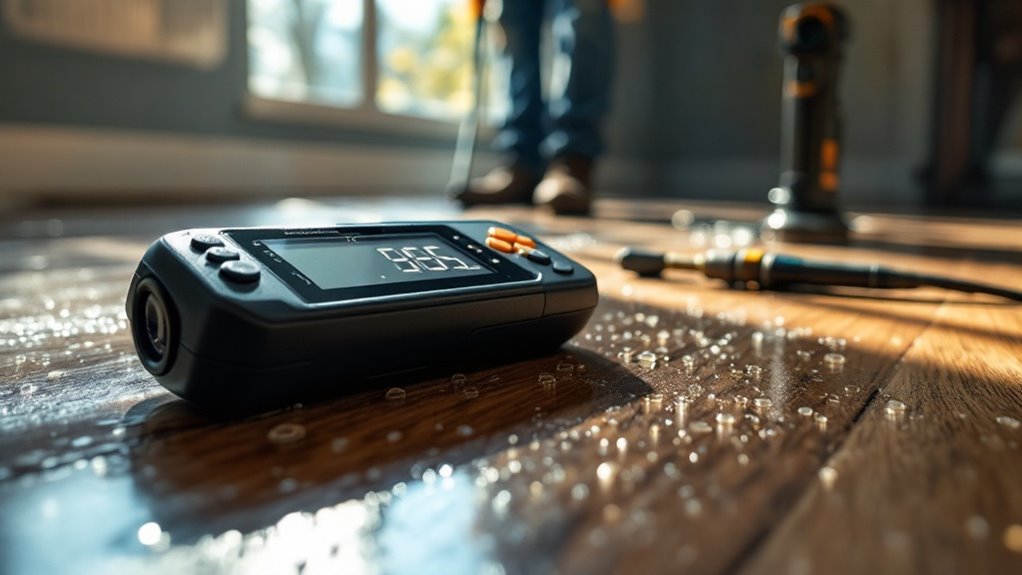After restoration, you might think your space is safe and sound, but lingering moisture can pose serious risks. It’s not just about aesthetics; unnoticed moisture can lead to mold, structural damage, and health issues. Understanding the importance of moisture checks is vital for maintaining a healthy environment. So, how do you guarantee your restoration efforts are truly effective? Let’s investigate the fundamental steps and tools you need to safeguard your home.
Key Takeaways
- Conducting moisture checks post-restoration ensures any residual dampness is detected and addressed to prevent mold growth.
- Regular monitoring helps maintain the structural integrity of the restored area, preventing future damage.
- Moisture checks safeguard against hidden leaks that could lead to costly repairs down the line.
- Utilizing specialized tools during inspections enhances accuracy in identifying lingering moisture issues.
- Early detection of moisture problems promotes good indoor air quality and a healthy living environment.
Understanding the Risks of Moisture After Restoration

After restoration, understanding the risks of lingering moisture is vital since it can lead to significant problems if not addressed promptly. Moisture can create an environment favorable to mold growth, which poses health risks and damages your property. You might not notice it immediately, but hidden moisture can compromise structural integrity, leading to costly repairs down the line. Furthermore, persistent dampness can attract pests, further complicating your situation. It’s important to monitor humidity levels and inspect areas like basements, attics, and behind walls regularly. By staying vigilant and proactive about moisture checks, you’ll protect your investment and guarantee a safe, comfortable living space. Remember, addressing moisture issues early can save you time, money, and stress in the long run. Additionally, mold exposure can lead to respiratory issues and other serious health concerns, making it crucial to keep moisture levels in check.
The Process of Conducting Moisture Checks
To effectively conduct moisture checks, you should start by gathering the right tools, such as a moisture meter and a flashlight. Once you have your tools, follow these steps for a thorough inspection:
- Identify areas of concern: Focus on spots previously affected by water damage.
- Use the moisture meter: Take readings on walls, floors, and ceilings to determine moisture levels.
- Check for visible signs: Look for mold, discoloration, or peeling paint that may indicate moisture issues.
- Document your findings: Keep a record of readings and observations for reference.
- Follow up: Schedule regular checks to verify moisture levels remain stable. Additionally, be aware of common sources of moisture that might contribute to future issues.
Tools and Techniques for Accurate Moisture Detection

When you’re aiming for accurate moisture detection, having the right tools and techniques at your disposal is vital. Begin with a moisture meter, which can provide immediate readings of moisture levels in various materials. Infrared cameras are likewise invaluable, as they help identify temperature variations, indicating potential moisture issues hidden behind walls. Utilizing a hygrometer can measure the humidity levels in the air, giving you a broader understanding of your environment. Don’t forget about thermal imaging, as it allows you to visualize moisture patterns that may not be immediately visible. Finally, a simple visual inspection can complement these tools, helping you catch any irregularities. Together, these methods guarantee a thorough approach to moisture detection and restoration. Additionally, working with an expert team for swift restoration ensures that any moisture issues are addressed promptly and effectively.
Common Signs of Hidden Moisture Issues
You might notice water stains on your walls or a musty odor lingering in the air, both of which can signal hidden moisture issues. Peeling paint or wallpaper is another red flag that shouldn’t be ignored. Recognizing these signs early can help you address problems before they escalate.
Water Stains on Walls
While water stains on walls can seem like mere cosmetic issues, they often signal underlying moisture problems that demand immediate attention. Ignoring these stains can lead to significant damage, so it’s essential to understand what they may indicate. Here are some common signs of hidden moisture issues you should look out for:
- Discoloration: Stains can vary in color, indicating different sources of moisture.
- Texture Changes: Walls may feel damp or warped.
- Peeling Paint or Wallpaper: This often occurs when moisture seeps behind the surface.
- Mold Growth: Stains might be accompanied by visible mold patches.
- Odors: A musty smell can develop, hinting at deeper moisture problems.
Addressing these signs promptly can prevent further complications and costly repairs.
Musty Odor Presence
How can a musty odor be a signal of hidden moisture issues? When you notice that distinctive smell, it often means there’s hidden moisture lurking somewhere in your home. This odor usually arises from mold or mildew, which thrive in damp environments. Even though you can’t see any obvious signs of water damage, that musty scent is your body’s way of alerting you to potential problems. Ignoring it can lead to more significant issues down the line, like structural damage or health concerns. It’s crucial to investigate further, checking areas like basements, crawl spaces, or behind walls. Taking action now can save you time and money in the long run, ensuring a safe and healthy living environment.
Peeling Paint or Wallpaper
The presence of a musty odor often signals moisture problems, which can manifest in various visible ways, including peeling paint or wallpaper. When you notice this, it’s essential to investigate further. Peeling surfaces aren’t just cosmetic issues; they often indicate hidden moisture issues that need addressing. Here are some signs to look for:
- Blistering paint or wallpaper
- Discoloration or staining on walls
- Soft or warped drywall
- Mold or mildew growth
- A damp or sticky feel to surfaces
Ignoring these signs can lead to more extensive damage. By addressing peeling paint or wallpaper promptly, you can prevent further problems and maintain your home’s integrity. Don’t overlook these indicators; they’re your home’s way of asking for help.
Benefits of Regular Moisture Monitoring
Regular moisture monitoring is key to preventing mold growth in your home. It additionally helps guarantee your structure stays sound and maintains good indoor air quality. By keeping an eye on moisture levels, you’re protecting both your health and your property.
Prevent Mold Growth
While you might think that a thorough restoration is enough to prevent mold, ongoing moisture monitoring is essential for keeping your space safe and healthy. Regular checks help you catch moisture issues early, so you can take action before mold sets in. Here are some benefits of consistent moisture monitoring:
- Early Detection: Spot hidden leaks before they become major problems.
- Health Protection: Reduce the risk of mold-related health issues for your family.
- Cost Savings: Prevent costly remediation by addressing moisture issues promptly.
- Peace of Mind: Feel confident knowing your environment is safe.
- Preservation: Maintain the integrity of your belongings and property.
Ensure Structural Integrity
Mold isn’t the only concern when it comes to moisture; unchecked humidity can likewise compromise the structural integrity of your home. Excess moisture can weaken wood beams, drywall, and insulation, leading to costly repairs down the line. By regularly monitoring moisture levels, you can catch problems early, preventing structural damage that could endanger your safety and comfort. It’s crucial to check areas like basements, attics, and behind walls where moisture may hide. Taking these proactive steps helps you maintain a stable environment, ensuring that your home remains safe and sound. With simple moisture checks, you can protect your investment and give yourself peace of mind knowing your home is structurally secure.
Maintain Indoor Air Quality
Maintaining ideal indoor air quality is essential for your health and comfort, especially since excess moisture can lead to the growth of allergens and irritants. Regular moisture monitoring helps you guarantee a safe environment by:
- Preventing mold growth that can worsen allergies
- Reducing dust mites and other indoor pollutants
- Enhancing overall respiratory health
- Improving comfort levels in your living space
- Lowering energy costs by optimizing HVAC efficiency
When to Seek Professional Help for Moisture Checks
When should you consider calling in the experts for moisture checks? If you notice persistent dampness, musty odors, or visible mold, it’s time to seek professional help. These signs can indicate underlying issues that DIY methods might miss. Furthermore, if you’ve recently experienced water damage, even after restoration, professionals can provide thorough inspections to verify everything’s dry. Regular moisture checks are crucial in preventing future problems, so don’t hesitate to reach out if you’re uncertain about your home’s condition. Experts use specialized tools to detect hidden moisture, which can save you from costly repairs down the line. Trusting professionals helps protect your home and maintain a healthy living environment. It’s better to be safe than sorry!
Conclusion
In the end, moisture checks after restoration aren’t just a precaution; they’re vital for your health and home’s longevity. You might think repairs are enough, but hidden moisture can sneak back in, leading to mold and costly damage. By regularly monitoring moisture levels, you’re not just protecting your investment—you’re creating a safer environment for you and your loved ones. So, don’t underestimate the power of a simple check; it could save you from future headaches.
